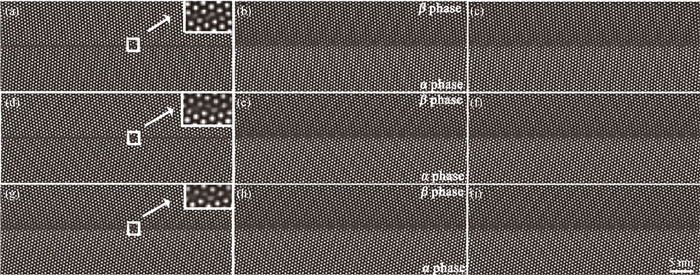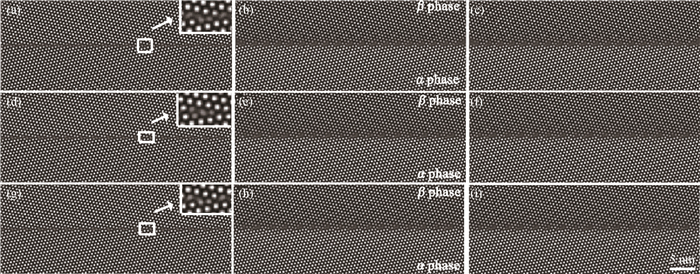Chinese Journal of Computational Physics ›› 2023, Vol. 40 ›› Issue (4): 416-424.DOI: 10.19596/j.cnki.1001-246x.8618
Previous Articles Next Articles
Wenjing MA1,2,3( ), Jin WANG1,2,3,*(
), Jin WANG1,2,3,*( ), Hui GUO1,2,3, Meini LYU1,2,3, Hongze ZHANG1,2,3, Dongde LI1,2,3
), Hui GUO1,2,3, Meini LYU1,2,3, Hongze ZHANG1,2,3, Dongde LI1,2,3
Received:2022-08-16
Online:2023-07-25
Published:2023-10-13
Contact:
Jin WANG
Wenjing MA, Jin WANG, Hui GUO, Meini LYU, Hongze ZHANG, Dongde LI. Phase Field Crystal Method Study on Inhibitory Mechanism of the Growth of Kirkendall Voids During Deformation Process at the Interface of Metal Micro Interconnect Structures[J]. Chinese Journal of Computational Physics, 2023, 40(4): 416-424.
Add to citation manager EndNote|Ris|BibTeX
URL: http://www.cjcp.org.cn/EN/10.19596/j.cnki.1001-246x.8618

Fig.5 Microstructure and morphology of Kirkendall voids (a)~(c) θ=4.8°; (d)~(f) θ=8.2°; (g)~(i) θ=9.4°; (a), (d), (g) t=1.0×105; (b), (e), (h) t=3.6×105; (c), (f), (i) t=8.6×105
| Y=Kttny | ||
| Kt | ny | |
| 4.8° | 2.522 77 | 0.128 3 |
| 8.2° | 2.894 74 | 0.126 57 |
| 9.4° | 2.341 47 | 0.112 9 |
Table 1 The growth exponent of Kirkendall voids
| Y=Kttny | ||
| Kt | ny | |
| 4.8° | 2.522 77 | 0.128 3 |
| 8.2° | 2.894 74 | 0.126 57 |
| 9.4° | 2.341 47 | 0.112 9 |

Fig.7 Microstructure and morphology of Kirkendall voids (a)~(c) θ=16.6°; (d)~(f) θ=18.4°; (g)~(i) θ=22.8°; (a), (d), (g) t=1.0×105; (b), (e), (h) t=3.6×105; (c), (f), (i) t=8.6×105
| Y=Kttny | ||
| Kt | ny | |
| 16.6° | 3.735 38 | 0.072 16 |
| 18.4° | 3.347 04 | 0.087 37 |
| 22.8° | 2.978 63 | 0.106 37 |
Table 2 The growth exponent of Kirkendall voids
| Y=Kttny | ||
| Kt | ny | |
| 16.6° | 3.735 38 | 0.072 16 |
| 18.4° | 3.347 04 | 0.087 37 |
| 22.8° | 2.978 63 | 0.106 37 |
| 1 |
DOI |
| 2 |
DOI |
| 3 |
DOI |
| 4 |
DOI |
| 5 |
DOI |
| 6 |
DOI |
| 7 |
DOI |
| 8 |
DOI |
| 9 |
DOI |
| 10 |
|
| 11 |
杨涛, 陈铮, 董卫平. 应力诱发双位错组亚晶界湮没的晶体相场模拟[J]. 金属学报, 2011, 47 (10): 1301- 1306.
|
| 12 |
|
| 13 |
|
| 14 |
|
| 15 |
|
| 16 |
高英俊, 卢昱江, 孔令一, 等. 晶体相场模型及其在材料微结构演化中的应用[J]. 金属学报, 2018, 54 (2): 278- 292.
|
| 17 |
马文婧, 柯常波, 周敏波, 等. Sn/Cu互连体系界面和金属间化合物层Kirkendall空洞演化和生长动力学的晶体相场法模拟[J]. 金属学报, 2015, 51 (7): 873- 882.
|
| 18 |
马文婧. 金属微互连结构中Kirkendall空洞和微裂纹生长行为的晶体相场法模拟研究[D]. 广州: 华南理工大学, 2017.
|
| 19 |
|
| 20 |
DOI |
| 21 |
DOI |
| 22 |
|
| 23 |
|
| 24 |
|
| 25 |
|
| 26 |
KIM B J, LIM G T, KOM J, et al. Intermetallic compound and Kirkendall void growth in Cu pillar bump during annealing and current stressing[C]//Proceeding of the 58th Electronic Components and Technology Conference, IEEE, Lack Buena Vista, 2008: 336-340.
|
| 27 |
|
| 28 |
|
| [1] | Xiyuan YANG. Effect of Nanovoid on Deformation Behavior of Ni/Ni3Al Nanowires: Atomisitic Simulation [J]. Chinese Journal of Computational Physics, 2022, 39(6): 727-732. |
| [2] | Jin WANG, Wen-jing MA, Yu-zhou LIU, Mei-ni LÜ, Kai-jing ZHANG. Morphological Evolution and Growth Kinetics in Primary Crystallization of Amorphous: Phase Field Method [J]. Chinese Journal of Computational Physics, 2022, 39(4): 403-410. |
| [3] | Zhaoyang HOU, Yuan NIU, Qixin XIAO, Zhen WANG, Qingtian DENG. Simulation of Mechanical Behavior and Deformation Mechanism of Al Nanowires Along Different Crystal Orientations [J]. Chinese Journal of Computational Physics, 2022, 39(3): 341-351. |
| [4] | Hongming LI, Maosheng LI. Effect of Irradiation on Mechanical Properties of Polycrystalline Copper: Crystal Plasticity Finite Element Method [J]. Chinese Journal of Computational Physics, 2022, 39(1): 6-16. |
| [5] | ZHANG Xueliang, TAN Huili, TANG Guoning, DENG Minyi. Mechanical Deformation of Myocardial Tissue with Cellular Automaton [J]. CHINESE JOURNAL OF COMPUTATIONAL PHYSICS, 2018, 35(3): 294-302. |
| [6] | GAO Yingjun, YANG Ruilin, HUANG Lilin, LIU Yao. Phase Field Crystal Simulation in Nano-scale for Crack Extension with Pre-deformation [J]. CHINESE JOURNAL OF COMPUTATIONAL PHYSICS, 2017, 34(4): 453-460. |
| [7] | YANG Zhonghua, LIU Guili, QU Yingdong, LI Rongde. First Principles Study on Adsorbing of Fe on N Doping Carbon Nanotube Rings [J]. CHINESE JOURNAL OF COMPUTATIONAL PHYSICS, 2016, 33(3): 374-378. |
| [8] | WU Junlai, LIU Yuetian, LUO Jie. Numerical Simulation of Fluid-Solid Coupling in Fractured Stress-sensitive Reservoirs [J]. CHINESE JOURNAL OF COMPUTATIONAL PHYSICS, 2014, 31(4): 455-464. |
| [9] | LIN Yanzhong, CHEN Bing, XU Xu. Radial Basis Function Interpolation in Moving Mesh Technique [J]. CHINESE JOURNAL OF COMPUTATIONAL PHYSICS, 2012, 29(2): 191-197. |
| [10] | Duan Qingsheng, Chang Tieqiang, Zhang Weiyan, Wang Guangyu, Wang Chongji. Numerical simulation of the plasma flow in laser hohlraum target [J]. CHINESE JOURNAL OF COMPUTATIONAL PHYSICS, 1999, 16(6): 610-615. |
| [11] | Chen Faliang. THERMAL AND MECHANICAL RESPONSE OF AN INTERNALLY-PRESSED SPHERIC SHELL TO IRRADIATION OF HIGH POWER LASER [J]. CHINESE JOURNAL OF COMPUTATIONAL PHYSICS, 1994, 11(3): 269-277. |
| [12] | Gui Xingen. THE DYNAMIC ELASTIC-PLASTIC DEFORMATION OF THE FREE CONICAL SHELL [J]. CHINESE JOURNAL OF COMPUTATIONAL PHYSICS, 1992, 9(4): 375-376. |
| Viewed | ||||||
|
Full text |
|
|||||
|
Abstract |
|
|||||
Copyright © Chinese Journal of Computational Physics
E-mail: jswl@iapcm.ac.cn
Supported by Beijing Magtech Co., Ltd.
